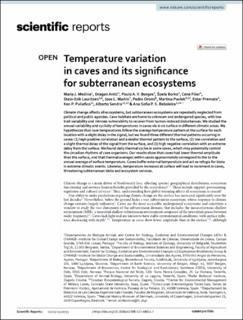| dc.contributor.author | Medina, Maria J. | |
| dc.contributor.author | Antić, Dragan | |
| dc.contributor.author | Borges, Paulo A V | |
| dc.contributor.author | Borko, Špela | |
| dc.contributor.author | Fišer, Cene | |
| dc.contributor.author | Lauritzen, Stein Erik | |
| dc.contributor.author | Martín, Jose L. | |
| dc.contributor.author | Oromí, Pedro | |
| dc.contributor.author | Pavlek, Martina | |
| dc.contributor.author | Premate, Ester | |
| dc.contributor.author | Puliafico, Ken P. | |
| dc.contributor.author | Sendra, Alberto | |
| dc.contributor.author | Reboleira, Ana Sofia P S | |
| dc.date.accessioned | 2024-02-23T11:49:30Z | |
| dc.date.available | 2024-02-23T11:49:30Z | |
| dc.date.created | 2023-12-13T08:16:22Z | |
| dc.date.issued | 2023 | |
| dc.identifier.issn | 2045-2322 | |
| dc.identifier.uri | https://hdl.handle.net/11250/3119624 | |
| dc.description.abstract | Climate change affects all ecosystems, but subterranean ecosystems are repeatedly neglected from political and public agendas. Cave habitats are home to unknown and endangered species, with low trait variability and intrinsic vulnerability to recover from human-induced disturbances. We studied the annual variability and cyclicity of temperatures in caves vis-à-vis surface in different climatic areas. We hypothesize that cave temperatures follow the average temperature pattern at the surface for each location with a slight delay in the signal, but we found three different thermal patterns occurring in caves: (1) high positive correlation and a similar thermal pattern to the surface, (2) low correlation and a slight thermal delay of the signal from the surface, and (3) high negative correlation with an extreme delay from the surface. We found daily thermal cycles in some caves, which may potentially control the circadian rhythms of cave organisms. Our results show that caves had lower thermal amplitude than the surface, and that thermal averages within caves approximately correspond to the to the annual average of surface temperature. Caves buffer external temperature and act as refugia for biota in extreme climatic events. Likewise, temperature increases at surface will lead to increment in caves, threatening subterranean biota and ecosystem services. | en_US |
| dc.language.iso | eng | en_US |
| dc.publisher | Nature | en_US |
| dc.rights | Navngivelse 4.0 Internasjonal | * |
| dc.rights.uri | http://creativecommons.org/licenses/by/4.0/deed.no | * |
| dc.title | Temperature variation in caves and its significance for subterranean ecosystems | en_US |
| dc.type | Journal article | en_US |
| dc.type | Peer reviewed | en_US |
| dc.description.version | publishedVersion | en_US |
| dc.rights.holder | Copyright 2023 The Author(s) | en_US |
| dc.source.articlenumber | 20735 | en_US |
| cristin.ispublished | true | |
| cristin.fulltext | original | |
| cristin.qualitycode | 1 | |
| dc.identifier.doi | 10.1038/s41598-023-48014-7 | |
| dc.identifier.cristin | 2212685 | |
| dc.source.journal | Scientific Reports | en_US |
| dc.identifier.citation | Scientific Reports. 2023, 13 (1), 20735. | en_US |
| dc.source.volume | 13 | en_US |
| dc.source.issue | 1 | en_US |

